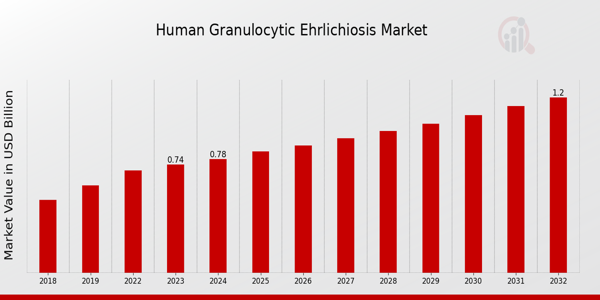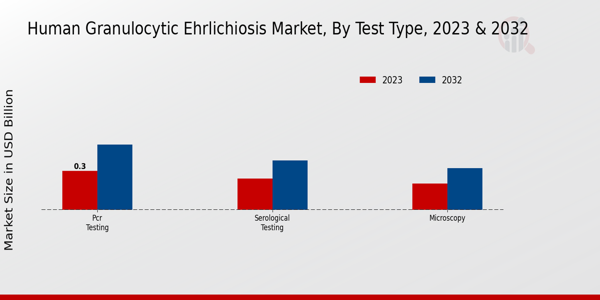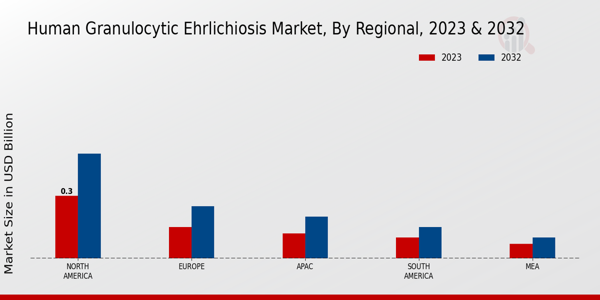Global Human Granulocytic Ehrlichiosis Market Overview
As per MRFR analysis, the Human Granulocytic Ehrlichiosis Market Size was estimated at 0.82 (USD Billion) in 2024. The Human Granulocytic Ehrlichiosis Market Industry is expected to grow from 0.87 (USD Billion) in 2025 to 1.40 (USD Billion) till 2034, at a CAGR (growth rate) is expected to be around 5.48% during the forecast period (2025 - 2034).
Key Human Granulocytic Ehrlichiosis Market Trends Highlighted
The Human Granulocytic Ehrlichiosis Market is experiencing significant growth driven by an increase in vector-borne diseases and the rising prevalence of tick-related infections. Heightened awareness among healthcare professionals and the public also plays a crucial role in this market expansion. Improved diagnostic techniques and advancements in treatment options are further enhancing patient outcomes, contributing to the market's progress. Opportunities within the Human Granulocytic Ehrlichiosis Market are ripe for exploration, particularly in developing innovative therapies and vaccines. As the incidence of ehrichiosis rises, there is a growing demand for effective preventive measures.Researchers and companies are encouraged to focus on novel drug development and diagnostic technologies, which could significantly alter the treatment landscape. Moreover, collaboration between public health agencies and pharmaceutical companies can create a more robust approach to tackle this disease. In recent times, trends indicate an increase in research initiatives aimed at understanding the pathogens causing Human Granulocytic Ehrlichiosis. Enhanced focus on vector control and community education is evident as stakeholders aim to minimize the impact of tick bites. The market is also witnessing a shift towards telemedicine as a viable option for patient evaluation and consultation, reflecting a change in healthcare delivery methods.Overall, the market is adapting to new challenges while also paving the way for significant advancements in the prevention and treatment of this condition, signifying a proactive approach to an evolving public health concern.

Source: Primary Research, Secondary Research, MRFR Database and Analyst Review
Human Granulocytic Ehrlichiosis Market Drivers
Increasing Incidence of Tick-Borne Diseases
The rise in the incidence of tick-borne diseases globally has significantly accelerated the growth of the Human Granulocytic Ehrlichiosis Market Industry. Factors such as environmental changes, urbanization, and an increase in human-animal interactions have contributed to the proliferation of tick populations, resulting in higher transmission rates of diseases like Human Granulocytic Ehrlichiosis. As the number of reported cases continues to rise, there is a growing demand for effective diagnostic tools and treatments to manage the disease.The awareness among healthcare professionals and the general public regarding the risks associated with tick exposure has also increased, further driving market growth. With advancements in healthcare technology, research institutions and companies are increasingly focused on the development of next-generation diagnostic solutions and therapeutics that can quickly detect and treat granulocytic ehrlichiosis. Furthermore, the government and various health organizations are allocating more resources towards public health initiatives that aim to educate populations about the prevention and management of tick-borne diseases.This, coupled with expanding research into more effective therapeutic options, will likely bolster the global market as stakeholders aim to meet the growing healthcare demand created by the rising prevalence of these conditions.
Growing Awareness and Research Investments
The Human Granulocytic Ehrlichiosis Market Industry is seeing substantial growth due to increased awareness about the disease among healthcare professionals and patients. Initiatives aimed at educating healthcare providers on the diagnosis and treatment of granulocytic ehrlichiosis are promoting early detection and better management of the disease. Additionally, increased investments in research and development of diagnostic tools and therapies are propelling market expansion.These research initiatives are driven by the ongoing need to understand the disease better and improve patient outcomes.
Advancements in Diagnostic Techniques
Innovations in diagnostic technologies have significantly impacted the Human Granulocytic Ehrlichiosis Market Industry. The development of rapid diagnostic tests and methodologies has enabled healthcare providers to identify the disease more accurately and efficiently. Enhanced testing capabilities lead to quicker case identification and treatment initiation, reducing the disease's burden. These advancements not only improve patient care but also increase the market's attractiveness to investors and pharmaceutical companies focusing on tick-borne diseases.
Human Granulocytic Ehrlichiosis Market Segment Insights:
Human Granulocytic Ehrlichiosis Market Test Type Insights
The Human Granulocytic Ehrlichiosis Market revenue is significantly influenced by the Test Type segment, which plays a vital role in disease diagnosis and management. This segment encompasses various testing methodologies, with PCR Testing emerging as a major force; it was valued at 0.3 USD Billion in 2023 and is projected to reach 0.5 USD Billion by 2032. The dominance of PCR Testing can be attributed to its high sensitivity and specificity, making it an essential tool for the rapid and accurate detection of Ehrlichiosis, thereby driving its widespread adoption in clinical settings.Following PCR, Serological Testing holds a substantial share in the market, valued at 0.24 USD Billion in 2023 and expected to grow to 0.38 USD Billion by 2032. This testing method is crucial for identifying antibodies against the Ehrlichia bacteria in patients, providing critical information for clinical decision-making and guiding treatment strategies. Microscopy, while valuable, is relatively less prominent in the overall market, with a valuation of 0.2 USD Billion in 2023 and projected to increase to 0.32 USD Billion by 2032; it is primarily utilized in research and has a lesser role in routine diagnostics due to the need for skilled personnel and increased time consumption.Overall, the Human Granulocytic Ehrlichiosis Market segmentation reveals that PCR Testing is poised to maintain a dominant position due to its technical advantages, with Serological Testing also contributing significantly to market growth. As the awareness surrounding these testing methods increases, there will likely be substantial opportunities for advancements in diagnostic solutions that can further enhance disease detection capabilities. The market trends emphasize investment in innovative technologies that streamline testing processes while improving accuracy, addressing the growing demand for effective diagnostic tools in the healthcare sector.

Source: Primary Research, Secondary Research, MRFR Database and Analyst Review
Human Granulocytic Ehrlichiosis Market End User Insights
The Human Granulocytic Ehrlichiosis Market revenue reflects a diverse landscape across its End User segment, encompassing Hospitals, Diagnostic Laboratories, and Research Institutions. As of 2023, the market is valued at 0.74 billion USD, positioning it for steady growth as it caters to the rising demand for accurate diagnostics and effective treatments. Hospitals play a crucial role in patient care and disease management, often accounting for a major share of the market due to their direct involvement in patient diagnostics and treatment protocols.Diagnostic Laboratories also hold a significant position, as they are vital for the identification of Human Granulocytic Ehrlichiosis, facilitating timely treatment and contributing to improved patient outcomes. Furthermore, Research Institutions are essential for advancing knowledge and developing innovative treatments, thus fostering growth within the Human Granulocytic Ehrlichiosis Market industry. The interplay among these segments is driven by the increased prevalence of vector-borne diseases and a growing emphasis on research and development, highlighting opportunities for advancements in diagnostic techniques.Challenges such as funding for research and variations in healthcare infrastructure may influence market dynamics, yet overall, the market statistics suggest a positive trend toward enhanced healthcare solutions.
Human Granulocytic Ehrlichiosis Market Distribution Channel Insights
The Distribution Channel segment of the Human Granulocytic Ehrlichiosis Market is crucial for enhancing product accessibility and maximizing outreach to healthcare providers and patients. In 2023, the market was valued at 0.74 billion USD, highlighting a significant upward trajectory in the years leading to 2032. Various distribution methods contribute uniquely, with Direct Sales playing a vital role by enabling personalized service and building strong relationships with clients. Online Sales have become increasingly important given the growing trend toward digital commerce, facilitating easy access to critical health information and products.Moreover, Distributors possess a strong network that enhances product penetration in various regions, ensuring that essential treatments reach a wider audience. Collectively, these channels support the overall growth and expansion of the Human Granulocytic Ehrlichiosis Market, addressing the rising need for efficient diagnosis and treatment options in the healthcare landscape. Insights from Human Granulocytic Ehrlichiosis Market data and trends indicate that leveraging these distribution channels could further stimulate market growth, given the current emphasis on improving healthcare accessibility.
Human Granulocytic Ehrlichiosis Market Regional Insights
The Human Granulocytic Ehrlichiosis Market is projected to achieve a revenue of 0.74 USD Billion in 2023, with notable growth across various regions. North America holds a significant share, generating 0.3 USD Billion in 2023 and expected to grow to 0.5 USD Billion in 2032, making it a major contributor to the market. Europe follows, with a market valuation of 0.15 USD Billion in 2023, anticipated to reach 0.25 USD Billion in 2032, reflecting steady growth driven by increasing awareness and diagnostic advancements. The APAC region, showing potential, starts at 0.12 USD Billion in 2023 and may increase to 0.2 USD Billion by 2032.South America and MEA, while smaller markets, demonstrate growth, with valuations of 0.1 USD Billion and 0.07 USD Billion in 2023, respectively, moving to 0.15 USD Billion and 0.1 USD Billion in 2032. This distribution highlights the dominance of North America and Europe in the Human Granulocytic Ehrlichiosis Market, driven by a higher prevalence of cases and robust healthcare infrastructure, while APAC presents emerging opportunities for growth in the future, as awareness and treatment options expand.

Source: Primary Research, Secondary Research, MRFR Database and Analyst Review
Human Granulocytic Ehrlichiosis Market Key Players and Competitive Insights:
The Human Granulocytic Ehrlichiosis Market is an area of significant interest for medical and research organizations due to the increasing prevalence of tick-borne diseases, notably those caused by the Ehrlichia species. This market is characterized by a wide range of diagnostic and therapeutic solutions aimed at combating Human Granulocytic Ehrlichiosis, which is caused by the bacterium Ehrlichia ewingii or related species. The competitive landscape is influenced by factors such as technological innovation, research and development initiatives, strategic collaborations, and the growing awareness of vector-borne diseases among healthcare providers and patients. As the demand for effective diagnostic tests and therapeutic options increases, players in this market are continually evolving their strategies to enhance their position and meet the needs of healthcare systems around the world.Siemens Healthineers has established itself as a leading player in the Human Granulocytic Ehrlichiosis Market by leveraging its advanced diagnostic technologies and comprehensive product offerings. The company's strength lies in its robust portfolio of highly accurate diagnostic tools that facilitate the timely detection of infections. Siemens Healthineers benefits from its extensive experience in the medical technology field, allowing it to provide reliable solutions that enhance clinical decision-making. Furthermore, its dedication to research and development fosters innovation, ensuring that they remain at the forefront of advancements in the diagnosis and treatment of tick-borne illnesses. Siemens Healthineers' commitment to quality, along with their strong global sales and distribution networks, enhances their market presence and strengthens their competitive edge in the sector.Meridian Bioscience plays a vital role in the Human Granulocytic Ehrlichiosis Market through its focus on developing specialized diagnostic assays aimed at detecting Ehrlichia infections. This company is known for its innovative approach to product development, providing unique solutions that cater specifically to clinicians’ needs when diagnosing granulocytic ehrlichiosis. Meridian Bioscience’s strengths include a proven track record of successful launches of diagnostic test kits, which are designed to be user-friendly and provide quick results. The company is committed to maintaining high-quality standards in their products, which instills trust among healthcare providers and contributes to strong brand loyalty. Their strategic collaborations and partnerships in the research community further enhance their ability to stay updated on the latest scientific advancements, ensuring that they continue to meet the evolving demands of the Human Granulocytic Ehrlichiosis Market.
Key Companies in the Human Granulocytic Ehrlichiosis Market Include:
- Siemens Healthineers
- Meridian Bioscience
- Beckman Coulter
- BioRad Laboratories
- Thermo Fisher Scientific
- Hologic
- Becton Dickinson
- DiaSorin
- Abbott Laboratories
- Roche Holding
- AbbVie
- Quest Diagnostics
- Genomic Health
- HoffmannLa Roche
- Cepheid
Human Granulocytic Ehrlichiosis Market Industry Developments
Recent developments in the Human Granulocytic Ehrlichiosis Market have seen increasing attention due to the rise in human tick-borne diseases. Companies like Siemens Healthineers and Thermo Fisher Scientific are innovating diagnostic solutions that enhance detection rates of Ehrlichiosis through advanced testing technologies. Current affairs indicate a notable increase in research funding allocated towards understanding and combating tick-borne diseases, with organizations pushing for better public health strategies. In terms of mergers and acquisitions, there have been no major announcements from key players like Abbott Laboratories or Roche Holding within this specific market segment. However, companies continue to explore collaborations that enhance diagnostic capabilities, such as partnerships between Hologic and DiaSorin. Additionally, significant growth in market valuation for firms like BioRad Laboratories and Becton Dickinson has been reported, driven by their commitment to developing next-generation diagnostic kits. These advancements are expected to not only elevate the treatment landscape but also improve patient outcomes significantly, as companies position themselves to meet increasing demand for efficient and reliable testing methodologies.
Human Granulocytic Ehrlichiosis Market Segmentation Insights
- Human Granulocytic Ehrlichiosis Market Test Type Outlook
- PCR Testing
- Serological Testing
- Microscopy
- Human Granulocytic Ehrlichiosis Market End User Outlook
- Hospitals
- Diagnostic Laboratories
- Research Institutions
- Human Granulocytic Ehrlichiosis Market Distribution Channel Outlook
- Direct Sales
- Online Sales
- Distributors
| Report Attribute/Metric |
Details |
|
Market Size 2024
|
0.82 (USD Billion)
|
|
Market Size 2025
|
0.87 (USD Billion)
|
|
Market Size 2034
|
1.40 (USD Billion)
|
|
Compound Annual Growth Rate (CAGR)
|
5.48 % (2025 - 2034)
|
|
Report Coverage
|
Revenue Forecast, Competitive Landscape, Growth Factors, and Trends
|
|
Base Year
|
2024
|
|
Market Forecast Period
|
2025 - 2034
|
|
Historical Data
|
2020 - 2024
|
| Market Forecast Units |
USD Billion |
| Key Companies Profiled |
Siemens Healthineers, Meridian Bioscience, Beckman Coulter, BioRad Laboratories, Thermo Fisher Scientific, Hologic, Becton Dickinson, DiaSorin, Abbott Laboratories, Roche Holding, AbbVie, Quest Diagnostics, Genomic Health, F. HoffmannLa Roche, Cepheid |
| Segments Covered |
Test Type, End User, Distribution Channel, Regional |
| Key Market Opportunities |
Increasing awareness campaigns, Advancements in diagnostic technologies, Rising demand for effective treatments, Expansion in endemic regions, Collaborations with healthcare organizations |
| Key Market Dynamics |
Rising incidence of tick-borne diseases, Increased awareness and diagnosis rates, Advancements in diagnostic technologies, Growing untapped market potential, Expansion of healthcare infrastructure |
| Countries Covered |
North America, Europe, APAC, South America, MEA |
Frequently Asked Questions (FAQ) :
The Human Granulocytic Ehrlichiosis Market is expected to be valued at 1.40 USD Billion by 2034.
The market is expected to grow at a CAGR of 5.48% from 2025 to 2034.
North America is projected to hold the largest market share, valued at 0.5 USD Billion by 2032.
The market size for PCR Testing is expected to reach 0.5 USD Billion by 2032.
Key players include Siemens Healthineers, Meridian Bioscience, Beckman Coulter, and Thermo Fisher Scientific.
Serological Testing is projected to be valued at 0.38 USD Billion by 2032.
The market size for Microscopy is expected to be 0.32 USD Billion by 2032.
The APAC region is expected to have a market value of 0.2 USD Billion by 2032.
The market value for South America is anticipated to be 0.15 USD Billion by 2032.
Challenges may include regulatory hurdles and competition among key market players.

















